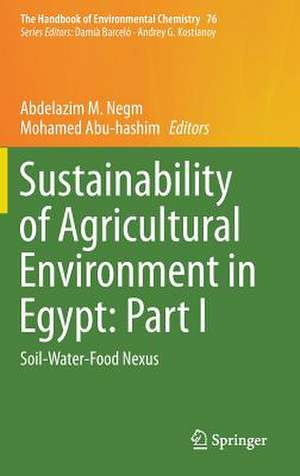Sustainability of Agricultural Environment in Egypt: Part I: Soil-Water-Food Nexus: The Handbook of Environmental Chemistry, cartea 76
Editat de Abdelazim M. Negm, Mohamed Abuhashimen Limba Engleză Hardback – 19 noi 2018
· Applicability of sustainable agriculture in Egypt
· Sustainable agriculture under water scarcity and polluted soil environments
· Improved crop productivity using a variety of tried and tested procedures · Biotechnology application for agricultural sustainability and food security
· Potentiality of soil-sensing for a more sustainable agricultural environment
The volume closes with a summary of the key conclusions and recommendations from all chapters. Together with the companion volume Sustainabilityof Agricultural Environment in Egypt: Part II, it offers an essential source of information for postgraduate students, researchers, and stakeholders alike.
Din seria The Handbook of Environmental Chemistry
- 18%
 Preț: 1819.46 lei
Preț: 1819.46 lei - 18%
 Preț: 1827.32 lei
Preț: 1827.32 lei - 18%
 Preț: 2102.76 lei
Preț: 2102.76 lei - 18%
 Preț: 2089.35 lei
Preț: 2089.35 lei - 18%
 Preț: 2481.57 lei
Preț: 2481.57 lei - 18%
 Preț: 1223.43 lei
Preț: 1223.43 lei - 5%
 Preț: 1419.56 lei
Preț: 1419.56 lei - 15%
 Preț: 639.41 lei
Preț: 639.41 lei -
 Preț: 392.97 lei
Preț: 392.97 lei - 5%
 Preț: 366.56 lei
Preț: 366.56 lei - 18%
 Preț: 1826.69 lei
Preț: 1826.69 lei - 15%
 Preț: 640.71 lei
Preț: 640.71 lei - 18%
 Preț: 728.91 lei
Preț: 728.91 lei - 5%
 Preț: 1424.89 lei
Preț: 1424.89 lei - 18%
 Preț: 1225.94 lei
Preț: 1225.94 lei -
 Preț: 386.00 lei
Preț: 386.00 lei - 18%
 Preț: 732.70 lei
Preț: 732.70 lei - 15%
 Preț: 641.53 lei
Preț: 641.53 lei - 5%
 Preț: 1416.81 lei
Preț: 1416.81 lei - 15%
 Preț: 644.82 lei
Preț: 644.82 lei - 5%
 Preț: 1421.76 lei
Preț: 1421.76 lei -
 Preț: 386.39 lei
Preț: 386.39 lei -
 Preț: 389.49 lei
Preț: 389.49 lei - 5%
 Preț: 719.02 lei
Preț: 719.02 lei - 5%
 Preț: 714.63 lei
Preț: 714.63 lei - 18%
 Preț: 1215.22 lei
Preț: 1215.22 lei -
 Preț: 392.97 lei
Preț: 392.97 lei - 18%
 Preț: 1832.08 lei
Preț: 1832.08 lei - 15%
 Preț: 639.73 lei
Preț: 639.73 lei - 5%
 Preț: 1925.56 lei
Preț: 1925.56 lei -
 Preț: 381.98 lei
Preț: 381.98 lei - 5%
 Preț: 363.97 lei
Preț: 363.97 lei -
 Preț: 386.00 lei
Preț: 386.00 lei - 5%
 Preț: 1423.39 lei
Preț: 1423.39 lei - 15%
 Preț: 643.16 lei
Preț: 643.16 lei -
 Preț: 383.12 lei
Preț: 383.12 lei - 15%
 Preț: 642.51 lei
Preț: 642.51 lei - 5%
 Preț: 716.09 lei
Preț: 716.09 lei - 5%
 Preț: 1407.87 lei
Preț: 1407.87 lei - 18%
 Preț: 1231.01 lei
Preț: 1231.01 lei
Preț: 1227.67 lei
Preț vechi: 1497.16 lei
-18% Nou
Puncte Express: 1842
Preț estimativ în valută:
234.99€ • 255.34$ • 197.52£
234.99€ • 255.34$ • 197.52£
Carte tipărită la comandă
Livrare economică 21 aprilie-05 mai
Preluare comenzi: 021 569.72.76
Specificații
ISBN-13: 9783319953441
ISBN-10: 3319953443
Pagini: 400
Ilustrații: XVI, 378 p. 60 illus.
Dimensiuni: 155 x 235 mm
Greutate: 0.73 kg
Ediția:1st ed. 2019
Editura: Springer International Publishing
Colecția Springer
Seria The Handbook of Environmental Chemistry
Locul publicării:Cham, Switzerland
ISBN-10: 3319953443
Pagini: 400
Ilustrații: XVI, 378 p. 60 illus.
Dimensiuni: 155 x 235 mm
Greutate: 0.73 kg
Ediția:1st ed. 2019
Editura: Springer International Publishing
Colecția Springer
Seria The Handbook of Environmental Chemistry
Locul publicării:Cham, Switzerland
Cuprins
Part I. Introduction.- Applicability of Sustainable Agriculture in Egypt.- Part II. Overview of Egyptian Sustainable Agriculture.- Deficit Irrigation Management as Strategy Under Conditions of Water Scarcity; Potential Application in North Sinai, Egypt.- Soil toxicology: Potential Approach on the Egyptian Agro-environment.- Part III. Potential application of crop productivity.- Potential Role of Intercropping in Maintaining and Facilitating Environmental Sustainability.- Role of Intercropping in Increasing Sustainable Crop Production and Reducing Food Gap in Egypt.- Sustainable Cultivation of Rice in Egypt.- Part IV. Biotechnology Application for Agricultural Sustainability.- Bioactive Compounds in Soybean Proteins and its Applications in Food Systems.- Influence of natural plant extracts in reducing soils & water contaminates.- Underutilized Plant Species and Agricultural Sustainability in Egypt.- Plant Biotechnology Status in Egypt.- Fermented Food in Egypt: A Sustainable Bio-preservation to Improve the Safety of Food.- Part V. Potentiality of Soil Sensing for Sustainable Agriculture.- Geostatistics and Proximal Soil Sensing for Sustainable Agriculture.- Sustainable Indicators in Arid Region; Case study – Egypt.- Implication of Geo-Informatics (GIS/RS) on Agricultural Irrigation Management: The State of the Art.- Importance of Forage Mixtures in Increasing Sustainable Food Supply in Egypt.- Hydrological Simulation of a Rainfed Agricultural Watershed using the Soil and Water Assessment Tool (SWAT).- Part VI. Conclusions.- Update, Conclusions, and Recommendations for Sustainability of the Agricultural Environment in Egypt: The Soil–Water–Food Nexus.
Textul de pe ultima copertă
This volume discusses the sustainability of Egypt’s agriculture and the challenges involved. It provides a comprehensive review and the latest research findings, and covers a variety of topics under the following themes:
· Applicability of sustainable agriculture in Egypt
· Sustainable agriculture under water scarcity and polluted soil environments · Improved crop productivity using a variety of tried and tested procedures
· Biotechnology application for agricultural sustainability and food security
· Potentiality of soil-sensing for a more sustainable agricultural environment
The volume closes with a summary of the key conclusions and recommendations from all chapters. Together with the companion volume Sustainability of AgriculturalEnvironment in Egypt: Part II, it offers an essential source of information for postgraduate students, researchers, and stakeholders alike.
· Sustainable agriculture under water scarcity and polluted soil environments · Improved crop productivity using a variety of tried and tested procedures
· Biotechnology application for agricultural sustainability and food security
· Potentiality of soil-sensing for a more sustainable agricultural environment
The volume closes with a summary of the key conclusions and recommendations from all chapters. Together with the companion volume Sustainability of AgriculturalEnvironment in Egypt: Part II, it offers an essential source of information for postgraduate students, researchers, and stakeholders alike.
Caracteristici
A comprehensive review Provides new insights into the challenges of a sustainable agriculture Will appeal to agronomists, scientists and policymakers alike
